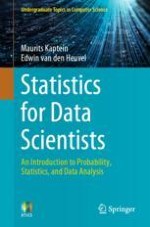
2022 | OriginalPaper | Buchkapitel
1. A First Look at Data
verfasst von : Maurits Kaptein, Edwin van den Heuvel
Erschienen in: Statistics for Data Scientists
Aktivieren Sie unsere intelligente Suche, um passende Fachinhalte oder Patente zu finden.
Wählen Sie Textabschnitte aus um mit Künstlicher Intelligenz passenden Patente zu finden. powered by
Markieren Sie Textabschnitte, um KI-gestützt weitere passende Inhalte zu finden. powered by
Abstract
face-data.csv throughout this chapter; this dataset, as well as all the other datasets we use throughout this book, is described in more detail in the preface. The dataset can be downloaded at http://www.nth-iteration.com/statistics-for-data-scientist. In this first chapter we will discuss techniques that help visualize and describe available data. We will use and introduce R, a free and publicly available statistical software package that we will use to handle our calculations and graphics. You can download R at https://www.r-project.org.